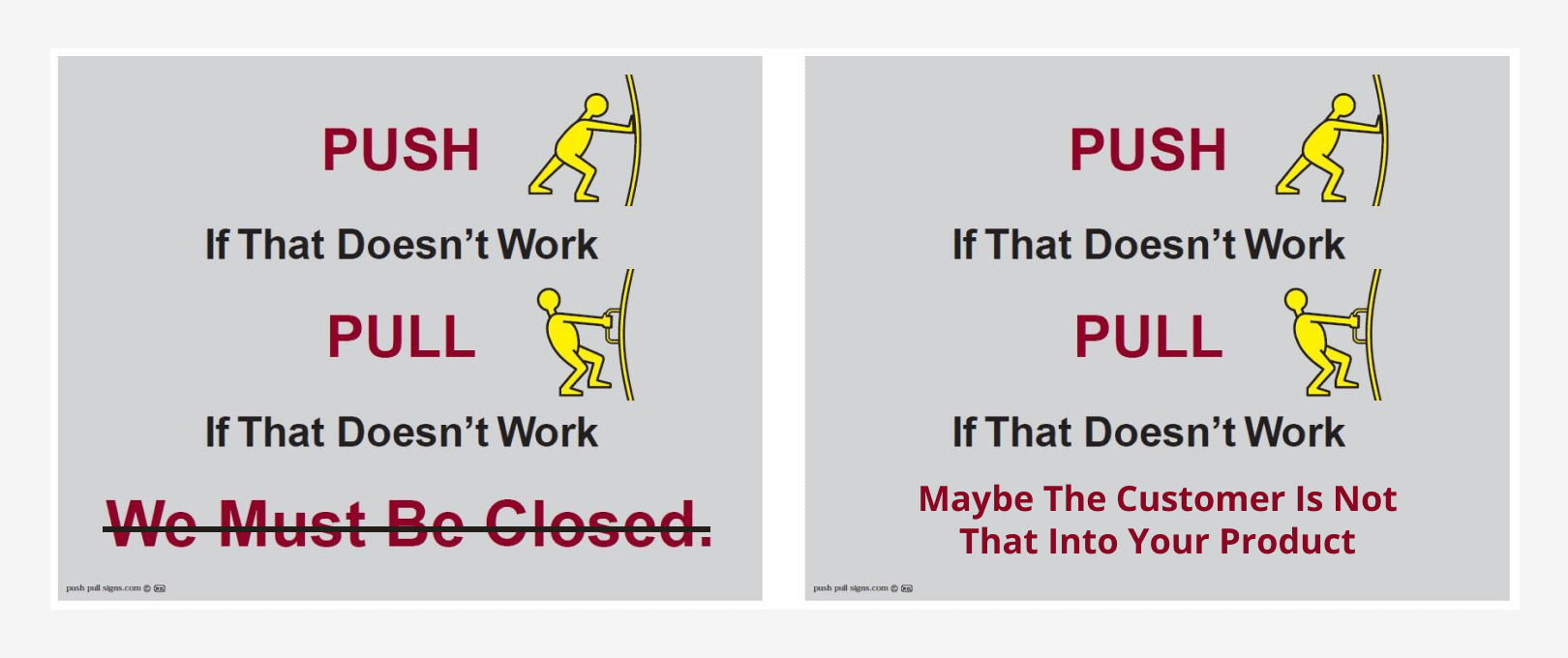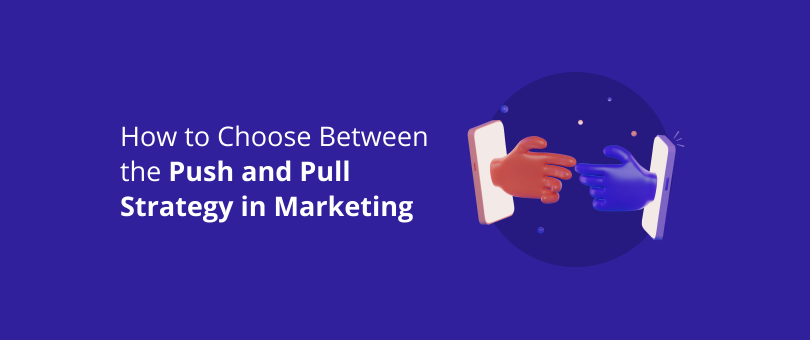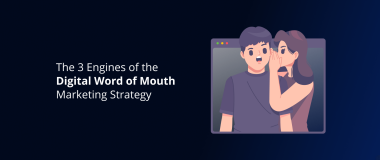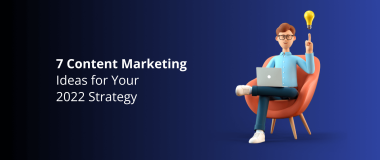In marketing, there are many different strategies that you can explore when pursuing your goals. You can build PPC campaigns, work on your SEO, invest in outdoor advertising, delve into content marketing, send emails, distribute flyers, even hire a mascot!
However, regardless of whether we are talking about digital or traditional tactics, all of these fall into two general categories – push and pull marketing. They share similarities and may even use the same communication channels but, at their core, they rely on completely different mindsets.
So how do you choose between the push and pull strategy in marketing, and should you really have to? The good news is that you don’t necessarily have to choose one over the other. Both strategies have their applications and can bring value to you and your customers.
Read on to find out more!
What Defines Push and Pull Marketing?
The main difference between push and pull marketing is in the way you approach the customer and the tactics you rely on to get their attention.
In fact, to achieve an optimal marketing performance and interact with your audience to the fullest, businesses should balance the two and let them complement each other. Which one you should rely on for a certain campaign depends on your goals at the moment and how soon you need results.

However, before we break down when to use push and pull marketing and how let’s first focus on the characteristics that define each one of them.
Push Marketing Strategy
In push marketing, also known as outbound marketing, as the name suggests, companies employ tactics that rely on unsolicited interactions with potential clients. Your goal is to put your marketing message out there and expose it to people who may or may not want or need your product.
Of course, your focus should be on those who fit a certain profile and match your buyer personas, even though there is no way to be sure that they are interested in what you have to offer.
Some of the tactics you can consider, depending on the types of products and services you are selling, are:
- PPC Ads
- Free Samples and Free Trials
- Social Media Ads
- Retargeting
- Trade Show Appearances
- Event Sponsorship
- Cross-Selling
- Strategic Product Positioning
- Website Banners and Pop-Ups
- Cold Outreach
- Outdoor Ads
- TV and Radio Ads
In a nutshell, push marketing is the type of advertising where you initiate communication and hope that the customer will be responsive, and will, indeed, need your products.
The foremost benefit of this type of strategy is that it delivers quick results and introduces your products to a broader audience of potential clients. It can also create a buzz around your brand and encourages people to choose you over the competition.
However, the disadvantages are that it is really expensive to maintain publicity with push marketing. The results it provides are short-term and can be unreliable when you are looking to build a lasting connection with your customers.
Also, people nowadays are becoming more and more resistant to direct advertising, and often consider it impersonal and intrusive.
Pull Marketing Strategy
In pull marketing, also known as inbound marketing, it’s the other way around – the customer finds you. Your goal here is to create content that answers the end-user’s needs, provides solutions to common issues, shows your expertise, and hints about your product’s qualities.
To succeed using this strategy, your pages should be well-optimized for search engines. Thus, customers who are actively researching solutions to a problem will find your content organically and may consider doing business with you.
While push marketing consists of a mix of traditional and digital tactics, the pull strategy relies mostly on your online presence:
- SEO Optimization
- Professional Blogging
- How-To Articles
- Guides
- Videos Tutorials
- Webinars
- Seminars
- Knowledge Base
- FAQ Pages
- Chatbots
- Word-of-Mouth Marketing
- Social Media Posts
- Online Reputation Management
- Brand Identity
- Customer Reviews
The greatest benefit of the pull strategy is that you can lure the customer in with your industry knowledge, all the while letting them think that your products were their own discovery. Thus, providing additional value and a better experience that influences how your clients feel about you.
Moreover, by offering your help free of charge and without imposing on the customer or invading their personal space, you build the foundation of a different type of connection and a more meaningful relationship. The pull strategy allows you to segment your audience while refining and personalizing your message, something customers value greatly.
The drawbacks of this approach are that building a successful campaign and witnessing the results don’t happen overnight. Constantly creating quality content and coming up with new ideas can be laborious and time-consuming. Also, SEO is an ongoing process where the rules are always changing so you need to stay up-to-date with new practices and algorithm updates.
When to Use Push Marketing
With push marketing tactics you can quickly spread the word about your business or remind customers about how great your products are. This makes them best applied when you want to attract immediate attention towards your company and products, and need your campaigns to deliver fast results.
Situations that call for an outbound strategy include, but are not limited to:
Building Brand Awareness
Push marketing is a great way to build brand awareness, regardless of whether you are a startup or an established name in your industry. Digital and traditional campaigns can spread your marketing message quickly and cover many different communication channels. This way, you can both reach a new target audience and encourage your existing customers to consider making another purchase.
Outbound outreach can improve your customer acquisition rates over a short period of time and give your business that much-needed boost when necessary.
Launching a New Product

If your company is actively involved in innovations and new product development, you probably already know how difficult it is to introduce a novel solution to the marketplace. People are often suspicious of brands and/or products that they are not familiar with, and that have not been backed up with peer recommendations. Especially if it is something completely new to the audience and there is no direct competition for the product in question.
A carefully curated mix of push tactics can attract the type of consumer eager to try innovations, and they can later become your brand advocates who inspire others. Even if the product is not that unique, an outbound strategy is a great way to let your prospective customers know what you offer, while convincing them that it is exactly what they need.
Boosting Sales Volume
Most companies have good products that could be successful but for one reason or the other are not selling that well. Launching a campaign to educate customers on the quality and usefulness of these products may increase their popularity and encourage people to give them a try.
Boosting sales volume can be done by pull tactics as well, but if you are looking for quick results, it’s best to rely on push marketing.
This tactic can also work when you are selling tangible products and are trying to clear up space in your warehouse for new arrivals. Launching discounts or BOGO (buy one, get one) deals and promoting them on different communication channels will do the job in no time.
Event-Related and Seasonal Initiatives
Events usually require time-sensitive marketing solutions because you need to attract your customers before your window of opportunity closes.
Push strategies will allow you to reach your audience swiftly and give them enough time to react. Depending on the type of clients you are targeting, you should publish ads where they tend to hang out, invest in outdoor advertising, and invest in all relevant paid channels.
While pull marketing can also help you with events in the form of interviews with participants, exclusive videos, behind-the-scenes footage, and so on, these may not fully reach your prospects, unless you have already invested enough in publicity.
Competing Against Rivals
We all know how brands use advertising to exchange witty comments and try to outmatch each other’s marketing messages.

Even if your rivalry isn’t as well-known as Coca-Cola’s and Pepsi’s, it’s a safe bet that you have competitors you want to outshine. By improving your brand awareness, push strategies can consolidate your position as the marketplace leader and show you like the more reliable choice.
Furthermore, people may claim they don’t trust advertising, however, if faced with a decision between an unfamiliar brand and one they’ve already been exposed to, 82% of people will go for the company they know.
If your push marketing tactics make you a household name and you can back this up with quality products and services, it will be much easier to beat the competition.
Entering a New Market
Similarly to when you are launching a new product, entering a new market can be a challenge. People may not yet be familiar with your solutions or how you can address their needs.
If you want to quickly grow your market share and establish leadership, you should rely on push methods to spread your marketing message and build awareness.
When to Use Pull Marketing
If the push strategy is how you make potential customers know about you, pull marketing is how you make them love you.
As mentioned, it is a long-term investment that can significantly improve your relationship with your customers.
Establishing Brand Authority
When you systematically publish relevant industry content that shows expertise and brings value to your customers, they will start to see you as an authority in your niche. This will improve your credibility and make you their preferred choice.
If your website is well-optimized and you are not skipping out on your SEO chores, you can rank well for business-related keywords. And although an organic search position is not a guarantee of product quality, it is reliant on a combination of optimization efforts.
Promoting Customer Retention

Push marketing can help you quickly accumulate new clients and boost sales, but, as we all know, customer retention is much more cost-effective than acquisition. And while you shouldn’t cease trying to bring in new leads, focusing on how to keep people around will allow you to grow your business exponentially.
By providing educational content to your customers, and helping them overcome obstacles in their day-to-day, you will improve customer satisfaction. What’s more, you are making sure that they will not leave simply because they don’t understand your product or are not using its full potential.
Clients who feel valued and have their needs met, will do business with you again.
Increasing Trust in Your Brand
When customers are aware of their needs and have been researching solutions, they may discover your content in an organic search or on social media platforms. Having a solid presence on these mediums will make you seem more reliable and trustworthy.
Furthermore, professionally written articles and guides that offer compelling and insightful information show your competence and build up your credibility.
Mid-funnel content like white papers and case studies shows that you know what you are doing and have already been helping customers who face the same issues as they do. This makes people more likely to trust you and give you a chance.
Building a Loyal Audience
By creating meaningful content that your customers will find worthwhile reading, you provide more value to them than when you are simply delivering a product. This shows people that you care and are ready to go the extra mile to provide an excellent brand experience.
Moreover, people nowadays are concerned with the quality of customer service, and by showing availability as well as providing resources they can refer back to, you are improving the way customers feel about you.
Happy customers that feel their interactions with your brand are valued, are more engaged and feel a deeper connection to you. This makes them more likely to remain loyal and choose you over the competition.
Bringing Traffic to Your Website

Inbound and SEO tactics can significantly improve organic traffic to your website. While, as mentioned, it takes time and serious effort to maintain the results once you obtain them, they’re worth it.
High-quality content that complies with the latest search engine regulations and standards, may earn you a top position in SERPs and once you are there, customers will notice you.
Research shows that the average CTR (click-through rate) of the #1 listing in Google’s organic search results is 31.7% and that this link is 10 times more likely to be clicked on than the one in position #10.
Creating content relevant to your niche and your customer’s interests and needs, and optimizing it well, will improve your online presence and will boost traffic to your website.
Encouraging Engagement
Actively publishing content and communicating with your audience across multiple channels creates the best kind of engagement. You are not only starting a conversation with your customers but are giving them something to talk about.
Brands that stay in touch with their followers on social media, reply to reviews and comments, and encourage any interaction, are generally more loved. People enjoy the attention and value the personal approach.
Also, by being active, you stimulate user-generated content (UGC) and word-of-mouth marketing. These are amongst the top driving forces behind your online reputation and are the most valuable assets to your pull strategy.
Bottom Line
Choosing between the push and pull strategy in marketing depends on what goals you are trying to achieve and how you want to approach your customers.
While many situations call for one strategy or the other, finding the balance between the two and building multidimensional campaigns is the optimal marketing solution for companies. This way, they can reach new audiences and engage them, and, at the same time, retain existing customers while building up their loyalty.





